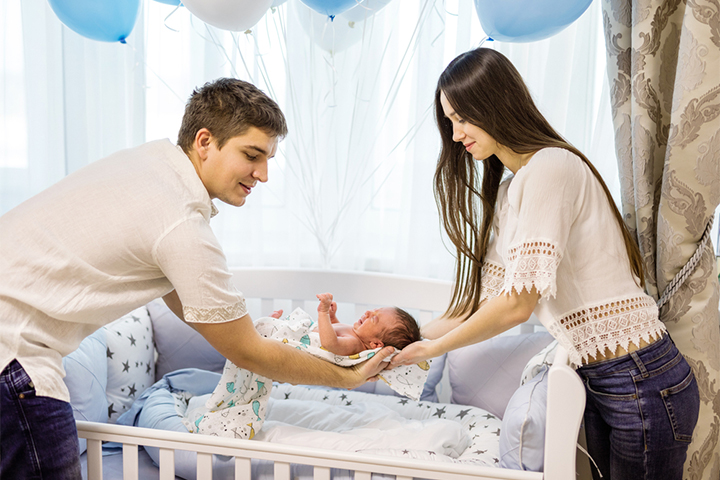Several babies can self-soothe themselves to sleep, while others need assistance from parents. If your baby falls in the latter category, trying the pick up, put down method might help. The pick up, put down sleep training method involves an entire process where you pick up the baby, soothe them, and then put them down to sleep. This process helps several babies sleep sound, which is essential for their proper growth and development.
Read on to learn about the pick up, put down sleep coaching method and tips to use the method effectively to put your baby to sleep.
What Is The Pick-Up, Put Down Method?
The pick up, put down method is a sleep training technique developed and mentioned by the British nurse Tracy Hogg in her book ‘Secrets of the Baby Whisperer: How To Calm, Connect, and Communicate With Your Baby.’ The method aims at soothing your baby to sleep without the need for them to learn self-soothing by crying (1).
Steps For The Pick Up, Put Down Method
The pick up, put down method focuses on the four S – setting the arrangement, settling the baby, sitting with the baby, and shushing, picking up, and putting down. Below is the elaboration of the four S of the pick up, put down method (2).
1. Setting the arrangement
- First, establish a nighttime and daytime sleep routine for the baby. It makes it easier for the baby to know when it is time to sleep. Also, the pick up, put down method focuses on improving the baby’s sleep quality and the ability to self-soothe. It does not work on establishing a sleep schedule.
- Choose a time when the baby is drowsy yet awake. This sleep training method may not work if the baby is extremely sleepy, tired, or cranky.
- Keep the baby’s crib and room ready for placing the baby in it.
2. Settling the baby
- Gently place the baby in the crib. You may swaddle the baby or offer them a pacifier if you do so usually.
- Do not pat the baby or shush them. You need to first wait for them to self-soothe to sleep.
3. Sitting with the baby
- Pull a chair and sit close to the crib. Remember not to talk or pat the baby if they are not crying since you need to first let them fall asleep on their own.
- You must remain in the room as long as the baby is awake. Once your baby falls asleep, leave the room.
- If you hear the baby’s cries, wait for a few seconds before entering the room. If the baby does not stop crying, enter the room to follow the next stage of this sleep training method.
4. Shushing, picking up, and putting down
- Shush the baby and pat them without picking them up from the crib. Give a few seconds for the baby to self-soothe without the need to pick them up.
- If the baby does not calm down, pick them up, and soothe them in your arms. You may rock them or sing them a lullaby at this stage.
- Put down the baby in the crib once they stop crying but are still awake. If your baby cries when you place them, repeat the shushing and patting while they are in the crib before picking them and calming them.
- Once the baby is in the crib, pull the chair and sit with the baby. Wait for them to fall asleep. If the baby cries again, pick them up, soothe them, and put them down,
- Sit on the chair and repeat the same steps from the “Sitting with the baby” step.
Does The Pick Up, Put Down Method Work?
Most babies respond well to this sleep training technique. Nevertheless, the pick up, put down method has its share of pros and cons like any other sleep training method (3).
Pros
- Focuses on teaching self-soothing to babies
- Can be customized by parents to meet their or baby’s needs
- Can be customized to make it gentle for sensitive babies
- Baby need not cry and stay alone when awake
- Parents may choose to sit with the baby all the time
- It may be emotionally rewarding for parents and babies than other sleep training methods that let the baby cry and self-soothe without parental intervention
Cons
- Could be tiring and exhausting for the parent, especially if they have another child
- May take a lot of time if the baby takes a long time to fall asleep
- Parent may have to stay close to the baby’s room all the time to listen the baby cry
- May not work with older babies and toddlers who may deliberately cry and throw tantrums for parent’s attention
At What Age Can You Try Pick Up, Put Down Method?
Sleep solutions such as this works best for infants between the ages of four and eight months (2). You may try this method once your baby is four months old. Avoid this training for newborns for up to three months since they require additional care and attention. Babies older than eight months may be difficult to sleep-train, and they may also test cause and effect by crying at night to gain parents’ attention.
How Long Does the Pick Up, Put Down Method Take To Work?
The time taken to reap the benefits of sleep techniques such as the pick up, put down method may vary, depending on the baby’s response and the consistency shown by parents. Pick up, put down method may take a week to three weeks to display results (2). However, some babies may show results within days, while some may take slightly longer than three weeks.
Liezl, a mother of a 14-month-old, shares how she stayed consistent with her approach despite facing some challenges initially. She says, “The whole time when she (my daughter) gets up, I put her down every time, so I did it like a million times, but really, the first night that I decided to start the sleep training was rough. It only took us 15 minutes the second night, and she slept until 5:30. The third night, as I put her down, she was just whining, and you know, she got up again, and then I put her back, she got up, but she was just talking, and then I put her down. Maybe we did it for like 10 minutes, and it was more of whining than crying, and she went to sleep. So I went back to my room. I watched her monitor the whole time, and she slept through the night.
“In the middle of the night, by the way, she woke up, but she did not even cry. She just got up, whined a little bit, and then fell back to sleep. I didn’t even have to go to her room. The fourth day I put her down, she whined for like a few seconds, and fell asleep. So it really works (i)!”
You may tell the method is working when the baby wakes up less number of times. The baby may sleep better since they have a sense of reassurance that their caregiver is always around to soothe them if they wake up. Babies who do wake up may go back to sleep before you enter the room to soothe them.
How To Make The Pick Up, Put Down Method Successful?
Below are some tips that could make the pick up, put down method effective and easy for both the parents and the baby.
- Try the method when there is stability in your and your baby’s sleep pattern and routine. Avoid infant sleep training when experiencing new events, such as change of house or a visit from guests.
- The baby should be in good health. Do not try this method or any sleep training method when the baby is unwell or has recovered from illness.
- Ensure that you are well-rested and in good health. Pick up, put down method may become exerting if you need to catch up on lost sleep.
- Take the help of your partner or another family member. Designate the task to check on the baby to someone else for alternate nights.
- Room-share with your baby if you are a single parent or the baby refuses to be soothed by anyone else but you. Place the baby’s crib close to the bed. Follow the same steps except that you do not have to leave the room. However, do not pick up the baby frequently or hold them for too long just because you are now closer to the baby throughout the night.
- Maintain consistency with the method since it helps babies learn better.
What If The Pick Up, Put Down Method Does Not Work?
If the method does not seem to work, give a break and try a few days to weeks later. Parenting and childcare strategies can play a crucial role in ensuring that the baby is comfortable and well-rested. Most babies usually respond to consistent sleep strategies such as the pick up, put down method well since the method involves receiving assurances from parents without the need for crying alone. Therefore, you may check for other potential interferences. For instance, check if the baby is well or if they are experiencing a life event, such as a growth spurt. You may also check if the baby’s room is comfortable and whether you are maintaining a consistent bedtime routine to prevent confusion for the baby. If your interventions do not work or the baby displays persistent sleep problems, speak to a pediatrician.
Other Sleep Training Methods
Below are some other sleep training methods for infants (3).
- Cry it out: It is a method where parents let the awakened baby cry alone for a fixed duration before they intervene to soothe the baby. The Ferber method is one of the most popular cry-it-out sleep training methods. It involves soothing the baby in the crib without picking them.
- Controlled crying: The parents let the awakened baby cry out for a gradually increasing time before intervening and pacifying the little one.
- Chair method: In this method, you place the baby and sit in the chair next to the crib. You remain seated while the baby sleeps. Gradually increase the distance of the chair from the crib each night. You soothe the baby verbally from a distance without picking them.
The pick-up, put-down method of sleep training may be exhausting for you as a parent since it may require you to wake up multiple times and for longer during the night. It is more suitable for younger babies and may not work if you try it on toddlers. Consistency and patience are key for achieving the expected results from this technique. Avoid trying it during illness, teething, regressions, or milestones. If you have any apprehensions or reservations about the technique, do not hesitate to discuss your doubts with your pediatrician.
Key Pointers
- The pick-up, put-down method is a sleep training strategy that aims at calming your baby to sleep.
- The method relies on the four S–setting the arrangement, settling the baby, sitting with the baby, and shushing, picking up, and putting down.
- Parents can also customize this method to meet their or baby’s needs; however, it may not work if your baby cries to get attention.
- When the infant is sick or is recovering, do not use this or any other sleep training technique.
If you are worried that your baby is not getting enough sleep then this video is for you. Check out this informative video and learn how the Pick Up Put Down Method, also known as The Sleep Nanny, is an effective way to help your baby sleep better.















